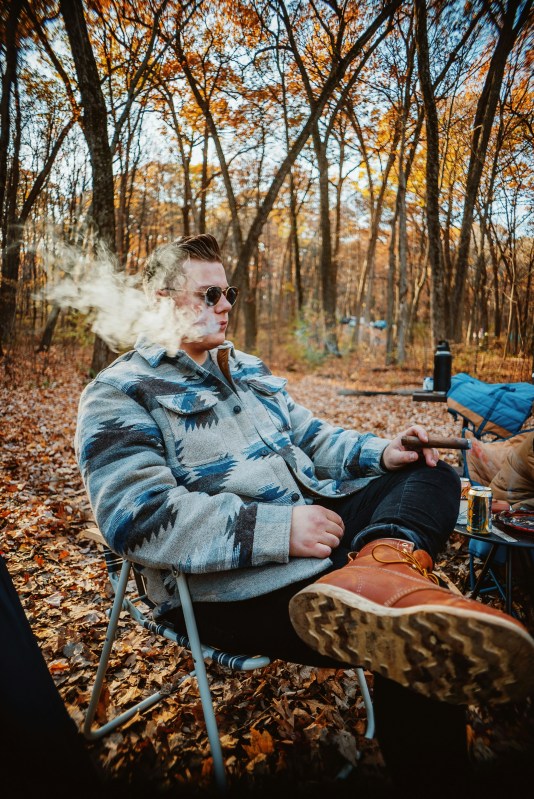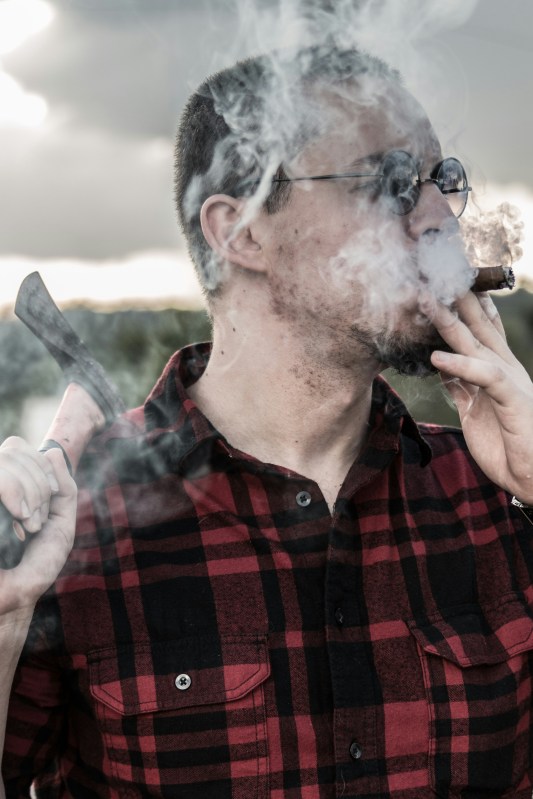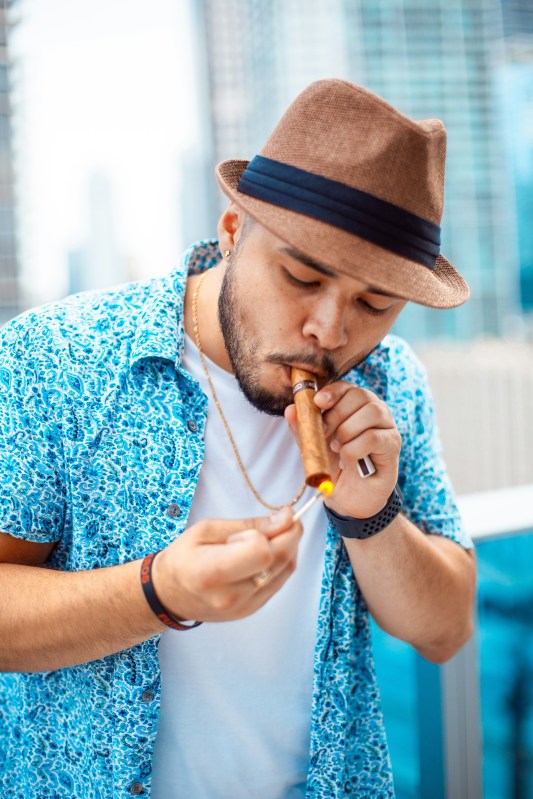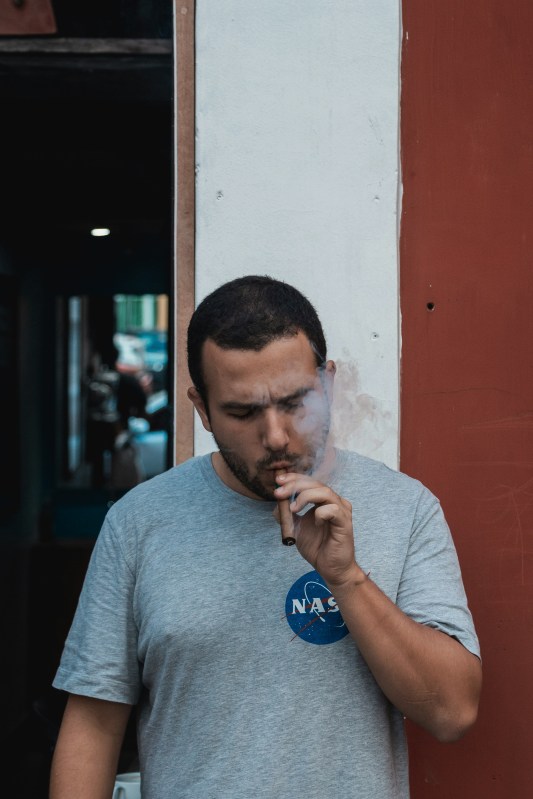Outdoor cigar smoking is one of life’s greatest joys—and also one of its most infuriating obstacles. There’s something magical about smoking a quality cigar outdoors—on the golf course after a perfect putt, at a backyard BBQ, or just unwinding on the patio. The open air, the freedom—things you can’t replicate indoors.
But Mama Nature doesn’t care about your $30 Cuban. She’ll crack your wrapper, tunnel your burn, and turn your relaxing smoke into a wrestling match faster than you can say “Montecristo.” Wind is especially merciless.
The good news is that with the appropriate knowledge, gear, and strategy, you can transform these outdoor challenges into minor annoyances. It’s not about fighting the elements, it’s about collaborating with them, adjusting your game plan, and showing up prepared.
Choose the right cigar for outdoor conditions

The first critical decision: which cigar to bring. Not every stick is made for outdoor duty.
Ring gauge matters. Go large — 50 and up. Big cigars are heavy and compact, less affected by wind, and more forgiving with burn issues.
A slim lancero might look classy in a lounge, but outside, it’s toast.
Authentic cigars with reliable build quality become key. Seek out real cigars that are densely packed with thick wrappers. Ecuador Sumatra, Habano, and Oscuro wrappers are your best buds. They’re hardy, sturdy, and aren’t going to crack at the hint of a gust. These wrappers have a thicker leaf structure and oils that help them stand up to the elements.
Don’t try fragile wrappers such as Cameroon when you’re out and about. They’re gorgeous and delicious, but they’re very delicate. Wind can crack them, split them, or burn them unevenly, transforming your luxury puff into a frustrated effort.
Stick with reliable brands. This isn’t the time to test a boutique blend. Brands such as Arturo Fuente, Padron, and Davidoff have earned their reputations offering cigars that deliver, even when the stars aren’t fully aligned.
Get the right tools for the job

You wouldn’t go camping without the proper gear, and smoking cigars outdoors calls for its unique kit. There’s a fine line between a fantastic outdoor smoke and a disaster, one that boils down to having the right tools.
- Windproof torch lighters are a must. Sure, your pimped out soft-flame lighter looks all elegant, but it’s worthless in anything beyond a light breeze. Torch lighters create a forceful, windproof flame that’ll light your stogie fast and dependably, even on windy days. The focused heat gives you an even toast on the foot of your cigar.
- Multi-flame torch lighters are even better, particularly for larger ring gauge cigars. They spread more heat coverage, helping you toast the foot evenly and more quickly. The more flames, the more butane you use, so have some extra fuel cans on hand.
- Windproof pocket ashtrays. There’s nothing that spoils the outdoor experience quite like seeing your hard-packed ash blow around in the wind. Windproof ashtrays with lids, small openings, or integrated windbreaks protect your smoking space and contain ash in its rightful place. A few even include magnetic bases that stick to metal surfaces—ideal for boat decks or metal patio furniture.
- Cigar holders & clips – these are lifesavers. These minimal gadgets hold your cigar when you need both hands or when the wind catches you off guard. They’re a godsend, in particular, for those deep outdoor sessions where you need to drop out for a minute. Seek out ones with non-damaging, adjustable grips.
- Travel humidors safeguard your investment. Outdoor elements can be a disaster for cigar freshness. Temperature swings, humidity changes, and direct sunlight can dry out your cigars or make them expand and contract, thus causing wrapper problems. A quality travel humidor with humidity packs keeps your stogies in optimal shape, whether you’re hitting the links or roughing it for a weekend.
Lighting up in the wind

How you light your cigar outside can be the difference between having a fantastic smoke or battling an uneven burn the next hour. This is where skill beats gear.
If you can, light your cigar indoors or in a protected location before venturing into the wind. Even just a few seconds of protection while you get that initial burn going can make all the difference. If inside is not an option, use your body, a structure, your vehicle, or even an umbrella to provide a windblock.
Work along with the wind, not against it. Either light with the wind at your back to protect the flame, or directly into the wind to control the burn. Ironically, into the wind usually works better because it makes you more careful, and you have more control over where the flame goes. Try to figure out what works best in your circumstances.
Slowly toast the foot evenly before your first puff, no rush. Keep the flame approximately 1/2 inch from the foot and turn the cigar slowly so that the entire surface is evenly warmed. The tobacco will begin to glow, and you may catch a wisp of smoke. Only then should you bring the cigar to your lips and take that initial puff.
A correctly toasted foot gets rid of canoeing (when one side burns faster than the other) and makes sure you get the full flavor spectrum as the blender intended. In windy conditions, this first step is even more important as the wind will intensify any irregularities in your burn.
Managing your cigar in the elements

Once you’ve nailed that magical lighting, the work truly starts. Outdoor smoking is not passive—you can’t kick back and puff away as you would do inside.
- Let the ash accumulate. In a twist of irony, a longer ash helps defend your cigar against the wind. The ash acts as an insulator, so the cherry isn’t directly exposed to the wind, and it holds a steady burn. Don’t brush it off right away. Let it accumulate to about an inch, then lightly tap it off.
- Rotate religiously. After every puff, rotate your cigar a quarter turn. This simple routine thwarts the wind’s impulse to burn one side more quickly than the other. It may seem almost obsessive at first, but it quickly becomes second nature, and your cigars will reward you with even, consistent burns.
- Try to avoid overpuffing. When wind is blowing on your burn, it’s tempting to want to puff more often to “keep it going.” Don’t. Excessive puffing causes the cigar to overheat, which generates harsh, bitter flavors that overwhelm the subtle notes you’re shelling out to savor. Instead, believe in the ritual and allow the cigar to smolder on its own time.
- Watch the burn line. Keep an eye on the evenness of your cigar’s burn. If you see one side getting ahead of the other, you can slow it down by angling that side away from the wind or blowing gently on the slower side to help it catch up. Minor adjustments now save time down the road.
Outdoor etiquette and comfort

Smoking outdoors means sharing, and being considerate isn’t just good manners — it’s crucial for maintaining cigar-friendly spaces outside.
- Watch your puff. Never forget where your smoke is blowing. Whenever available, sit downwind from others, and if you are in a communal space, ask the people nearby if they mind before lighting up. A little consideration does a lot to keep outdoor spaces stogie-friendly.
- Pick your location wisely. Choose solid, cozy chairs that won’t flip over in the breeze. Those outside smokes can go an hour or more, and you want to be comfortable. Think about sun exposure. Direct sunlight can heat your cigar unevenly and make you uncomfortable.
- Stay hydrated. Outdoor smoking, particularly in the heat, can be extremely dehydrating. Have water or your preferred beverage close by. Water correctly hydrates you, which keeps your palate fresh and avoids the dry mouth that can mask or alter flavors. A beverage is a huge plus, and it gives you something to do between puffs.
- Clean up completely. It’s not just nice, it’s about maintaining outdoor smoking privileges for all. Use appropriate ashtrays, properly dispose of cigar butts, and pack out all your trash. Leave no trace, and these spaces will remain welcoming for future sessions.
The bottom line

Relax, outdoor cigar smoking doesn’t have to mean fighting the elements. With the right cigars, tools, and technique, get premium smokes wherever the wind blows. The secret is preparation, patience, and respect for your cigars and your surroundings.
Keep in mind that what’s effective on a still summer night may not be so on a windy fall afternoon. Most of all, don’t let tough circumstances get you down. That payoff of a perfectly wrangled outdoor cigar—with the heavens above you, the fresh air surrounding you, and that feeling of conquering a wild environment—is worth every ounce of energy you expend.




